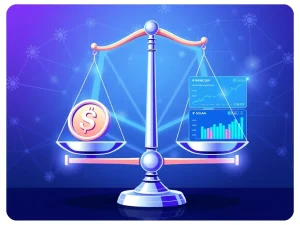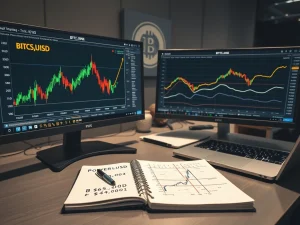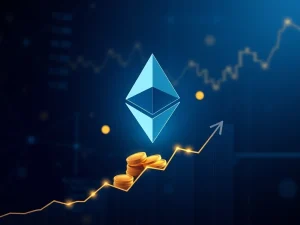Ethereum News Today: ETH Price Soars 65% Amidst Pivotal Crypto Market Shifts

The cryptocurrency world is buzzing, and for good reason! Ethereum news has been dominating headlines as the second-largest digital asset, ETH, has delivered an astonishing 65% rally over the past 30 days. This impressive surge comes as the broader crypto market navigates a complex web of global macroeconomic data, significant regulatory shifts, and a wave of exciting altcoin innovations. For investors and enthusiasts alike, understanding these intertwined forces is crucial for charting the path ahead in digital assets. Let’s dive into the key developments shaping this dynamic landscape.
Navigating Macroeconomic Currents: What’s Driving the Crypto Market?
The global financial landscape is currently a major influencer on the crypto market. This pivotal week kicked off with significant announcements, including a new U.S.-EU tariff agreement and a 90-day delay in U.S. customs duties on China. These trade dynamics often ripple through traditional markets and, by extension, impact investor sentiment towards risk assets like cryptocurrencies. The renewed institutional and retail interest, evidenced by Bitcoin surging to $120,000 and Ethereum nearing $3,900, suggests a growing confidence despite ongoing global shifts.
Market participants are closely watching a series of high-impact economic data releases from the U.S. These include:
- ADP Employment Report: Forecasted at 82,000, this data offers an early look at private sector job growth, influencing expectations for broader employment trends.
- Gross Domestic Product (GDP): Expected 2.4% growth, the GDP report provides a comprehensive measure of economic activity, indicating the overall health of the U.S. economy.
- Federal Reserve’s Rate Decision: While analysts anticipate no immediate rate cuts, the Fed’s stance and Chair Powell’s post-meeting press conference will be scrutinized for clues on future monetary policy. Any hawkish or dovish signals can significantly sway market sentiment.
- U.S. Jobless Claims & Core PCE Inflation: These reports are critical for assessing the Fed’s policy direction. Persistent inflation, particularly from sectors like rent, could push the Fed to maintain higher rates for longer, creating headwinds for risk assets.
Beyond U.S. borders, the Bank of Japan has maintained its rate stance, and the Eurozone CPI data (forecast at 1.9%) will cap the week’s economic calendar. The European Central Bank’s (ECB) recent rate pause adds another layer of uncertainty to global monetary policy, highlighting the interconnectedness of international economies and their influence on the crypto space.
Ethereum’s Explosive Ascent: A Closer Look at the ETH Price Rally
Amidst these macroeconomic considerations, the ETH price has emerged as a standout performer, rallying an impressive 65% over the last 30 days. This significant surge points to a potential shift in market leadership, with capital increasingly flowing into the Ethereum ecosystem and related decentralized finance (DeFi) advancements. The fact that Ethereum neared $3,900 underscores the renewed investor confidence and growing utility of the network.
Several factors contribute to Ethereum’s strong performance:
- DeFi Innovation: Ethereum remains the bedrock of the decentralized finance movement. New protocols, lending platforms, and decentralized exchanges (DEXs) continuously launch and mature on its network, driving demand for ETH as the native asset for gas fees and staking.
- Ecosystem Growth: Projects like Etherex, a new decentralized exchange developed by Consensys and Nile on Linea (an Ethereum Layer 2), exemplify the ongoing expansion of the Ethereum ecosystem. These developments enhance liquidity and utility, making Ethereum more attractive.
- Institutional Interest: While not explicitly detailed in the source, a 65% rally often suggests renewed institutional curiosity and investment, seeking exposure to the growing DeFi sector and Ethereum’s long-term potential.
- Staking Rewards: The continued success of Ethereum’s Proof-of-Stake consensus mechanism and attractive staking yields encourage long-term holding and participation, reducing selling pressure.
This rally positions Ethereum as a strong contender challenging Bitcoin’s traditional dominance, especially as investors seek higher growth potential in the altcoin space.
Altcoin Innovation Unleashed: Beyond Bitcoin and Ethereum
The current market isn’t just about Bitcoin and Ethereum; it’s also a hotbed for altcoin innovation. The broader momentum in this sector is palpable, with several projects making significant strides:
- Etherex Launch: As mentioned, this new DEX developed by Consensys and Nile on Linea (an Ethereum Layer 2) highlights the continuous efforts to improve scalability and user experience within the Ethereum ecosystem.
- Plasma’s Public Token Sale: Plasma, a stablecoin Layer-2 network, concluding its public token sale indicates a growing interest in scalable solutions for stablecoin transactions, crucial for mainstream adoption.
- Sui’s Ika Mainnet Transition: Sui’s Ika, described as a parallel multi-party computing network, transitioning to mainnet adds crucial infrastructure for decentralized applications, promising enhanced performance and new capabilities for developers and users.
- Algorand’s Roadmap: The publication of Algorand’s roadmap signals ongoing development and a clear vision for its future, aiming to attract more developers and projects to its platform.
- Zulu Network’s AI Pivot: The transition of Zulu Network to an AI project underscores the convergence of blockchain and artificial intelligence, a burgeoning area of innovation with immense potential.
While innovation thrives, the market also sees strategic pivots. Binance, for instance, is phasing out older app versions for enhanced facial recognition features, reflecting a push towards greater security and compliance. Simultaneously, Binance’s delisting of all League of Kingdoms (LOKA) trading pairs signals a strategic move away from what it deems volatile meme-token markets, emphasizing a focus on more sustainable projects.
The Shifting Sands of Crypto Regulation and Global Adoption
Regulatory developments continue to play a crucial role in shaping the crypto market. This week brings several key updates:
- UK’s FCA Stablecoin Custody Rules: The finalization of these rules by the Financial Conduct Authority (FCA) in the UK indicates a maturing regulatory environment, aiming to provide clarity and protection for stablecoin users and issuers.
- Hong Kong’s Stablecoin Regulations: Effective August 1, these regulations highlight Asia’s growing influence and proactive approach to integrating digital assets into its financial framework, potentially setting a precedent for other regions.
- Vietnam’s Blockchain Week: This event further underscores Asia’s expanding role in the global crypto scene, fostering innovation and adoption within the region.
- U.S. Digital Assets Leadership Report: This report is anticipated to provide insights into the U.S. government’s strategy for digital assets, which could significantly impact the regulatory direction and investor confidence in the country.
These regulatory efforts, while sometimes perceived as restrictive, are ultimately aimed at bringing legitimacy and stability to the crypto space, which can pave the way for broader institutional and retail adoption in the long run.
Navigating Risks and Opportunities in the Dynamic Crypto Market
The interplay between rapid altcoin innovation and fluctuating macroeconomic indicators is fundamentally reshaping investor priorities. While Ethereum’s strong performance, fueled by DeFi advancements, showcases immense potential, the market is not without its challenges.
Key risks persist from:
- Regulatory Ambiguity: Despite progress, a lack of clear, harmonized global regulations can create uncertainty and deter larger institutional investment.
- U.S. Inflation Resilience: Persistent inflation, particularly the surge in rent prices, could compel central banks, especially the Federal Reserve, to maintain a hawkish stance, potentially leading to higher interest rates and less liquidity for risk assets.
- Geopolitical Tensions: The U.S.-EU tariff deal’s impact on trade flows, alongside broader geopolitical uncertainties, can amplify market volatility, making asset prices sensitive to news cycles.
- Central Bank Policy Outcomes: The decisions of the Fed and ECB on interest rates will serve as critical pivot points, directly influencing capital flows and investor appetite for risk.
Despite these risks, the opportunities are compelling. The continuous stream of innovation, particularly in Layer-2 solutions, decentralized exchanges, and AI integration, suggests a robust future for the digital asset space. Investors are increasingly diversifying their portfolios beyond just Bitcoin, seeking higher returns in promising altcoin projects that offer tangible utility and solve real-world problems.
The current period demands a nuanced understanding of both technological advancements within the blockchain space and the broader global economic currents. Staying informed on macroeconomic data, regulatory shifts, and emerging altcoin projects will be paramount for navigating this exciting, yet unpredictable, market.
Frequently Asked Questions (FAQs)
1. What is driving the recent Ethereum price rally?
The recent 65% rally in Ethereum’s price is primarily driven by advancements in decentralized finance (DeFi), continuous innovation within its ecosystem (like new DEX launches), and renewed institutional and retail interest. The ongoing utility of ETH for gas fees and staking also contributes to its demand.
2. How are macroeconomic factors influencing the crypto market?
Macroeconomic factors such as U.S.-EU tariff agreements, delays in U.S. customs duties on China, and critical economic data releases (like ADP employment, GDP, and PCE inflation) significantly impact the crypto market. Federal Reserve interest rate decisions and global central bank policies also influence liquidity and investor sentiment towards risk assets like cryptocurrencies.
3. What are some key altcoin innovations mentioned in the article?
The article highlights several altcoin innovations, including the launch of Etherex (a Linea-based DEX), the conclusion of Plasma’s stablecoin Layer-2 token sale, Sui’s Ika network transitioning to mainnet, Algorand publishing its roadmap, and Zulu Network pivoting to an AI project. These developments underscore the ongoing evolution and expansion of the broader altcoin ecosystem.
4. How are global regulations shaping the crypto landscape?
Global regulations are increasingly shaping the crypto landscape by providing clarity and aiming to protect investors. Examples include the UK’s FCA finalizing stablecoin custody rules, Hong Kong implementing new stablecoin regulations, and the anticipated U.S. Digital Assets Leadership Report. These efforts are crucial for bringing legitimacy and stability, fostering broader adoption.
5. What are the main risks for crypto investors right now?
Key risks for crypto investors include persistent regulatory ambiguity across different jurisdictions, the resilience of U.S. inflation (especially rising rent prices) which could lead to tighter monetary policies, and geopolitical tensions that can amplify market volatility. Central bank policy outcomes, particularly interest rate decisions, also pose significant risks to asset prices.










